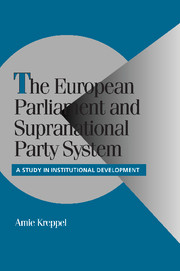Book contents
- Frontmatter
- Contents
- Figures
- Tables
- Acknowledgments
- 1 INTRODUCTION: THE EUROPEAN PARLIAMENT AND THE INSTITUTIONAL EVOLUTION OF LEGISLATURES
- 2 THEORIES OF LEGISLATIVE DEVELOPMENT AND THE EUROPEAN PARLIAMENT
- 3 THE DEVELOPMENT OF THE PARTY GROUP SYSTEM AND THE PARTY GROUPS
- 4 THE HISTORY OF THE EUROPEAN PARLIAMENT
- 5 THE INTERNAL DEVELOPMENT OF THE EUROPEAN PARLIAMENT: FROM COLLEGIALITY TO CONFLICT
- 6 THE DEVELOPMENT OF THE SUPRANATIONAL PARTY GROUP SYSTEM: CONFLICT AND COOPERATION IN THE COALITION FORMATION PROCESS
- 7 COOPERATION AND CO-DECISION: THE ROLE OF IDEOLOGY AND RULES
- 8 THE INTERNAL DEVELOPMENT OF THE SUPRANATIONAL PARTY GROUPS: AN ELUSIVE GOAL
- 9 CONCLUSIONS: UNDERSTANDING THE DEVELOPMENTAL PROCESS
- Appendices
- Bibliography
- Index
- Titles in the series
8 - THE INTERNAL DEVELOPMENT OF THE SUPRANATIONAL PARTY GROUPS: AN ELUSIVE GOAL
Published online by Cambridge University Press: 18 December 2009
- Frontmatter
- Contents
- Figures
- Tables
- Acknowledgments
- 1 INTRODUCTION: THE EUROPEAN PARLIAMENT AND THE INSTITUTIONAL EVOLUTION OF LEGISLATURES
- 2 THEORIES OF LEGISLATIVE DEVELOPMENT AND THE EUROPEAN PARLIAMENT
- 3 THE DEVELOPMENT OF THE PARTY GROUP SYSTEM AND THE PARTY GROUPS
- 4 THE HISTORY OF THE EUROPEAN PARLIAMENT
- 5 THE INTERNAL DEVELOPMENT OF THE EUROPEAN PARLIAMENT: FROM COLLEGIALITY TO CONFLICT
- 6 THE DEVELOPMENT OF THE SUPRANATIONAL PARTY GROUP SYSTEM: CONFLICT AND COOPERATION IN THE COALITION FORMATION PROCESS
- 7 COOPERATION AND CO-DECISION: THE ROLE OF IDEOLOGY AND RULES
- 8 THE INTERNAL DEVELOPMENT OF THE SUPRANATIONAL PARTY GROUPS: AN ELUSIVE GOAL
- 9 CONCLUSIONS: UNDERSTANDING THE DEVELOPMENTAL PROCESS
- Appendices
- Bibliography
- Index
- Titles in the series
Summary
The internal development of the party groups is perhaps the least studied aspect of the European Parliament. Although there are numerous books written on the party groups before (Van Oudenhove, 1965; Fitzmaurice, 1975) and immediately following direct elections (Pridham and Pridham, 1979, 1980; Henig, 1979, 1980; Guidi, 1983), almost nothing has been written since that specifically focuses on the internal organization of the groups. There is an emerging body of work that examines the voting cohesion of the party groups but fails to examine their internal organization beyond that (Attinà, 1990, 1992, 1993; Brzinski, 1995). Even the best attempt to discover the role of the party groups within the EP thus far (Raunio, 1996) still largely ignores the internal development of the groups themselves.
The reason for this lacuna is simple: There is very little available information on the internal development of the groups. For example, even the largest and most stable groups rarely keep organized records of their previous internal rules. Beyond the dearth of historical documents, and probably more important, is the informal nature of much of the internal organization of the party groups. As we shall see in this chapter, one of the most important aspects of internal party group organization is given only passing mention in the rules of both of the two largest groups (the EPP and the PES). In effect, there are very little quantitative or consistent data on the internal development of the groups available.
- Type
- Chapter
- Information
- The European Parliament and Supranational Party SystemA Study in Institutional Development, pp. 177 - 211Publisher: Cambridge University PressPrint publication year: 2001

